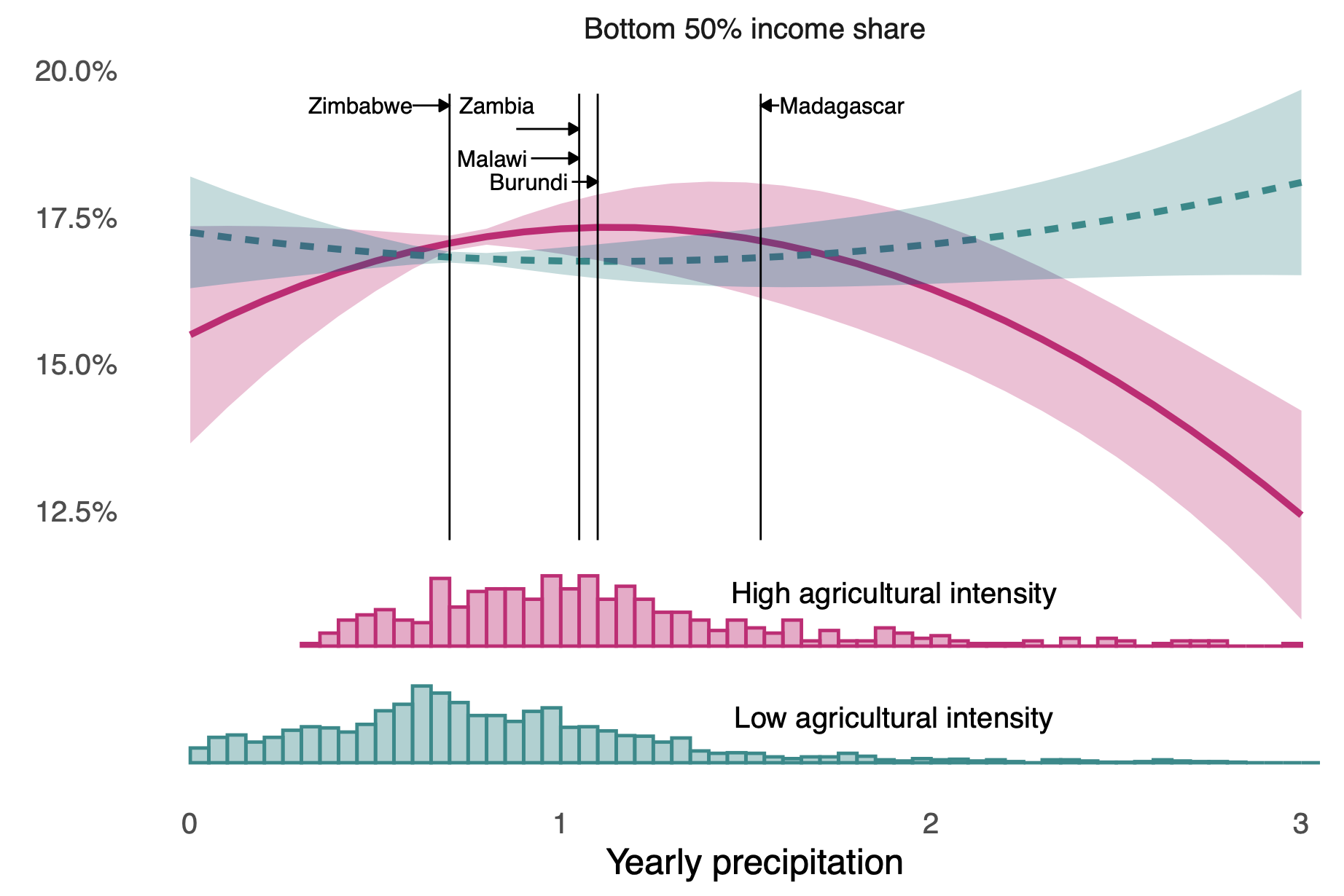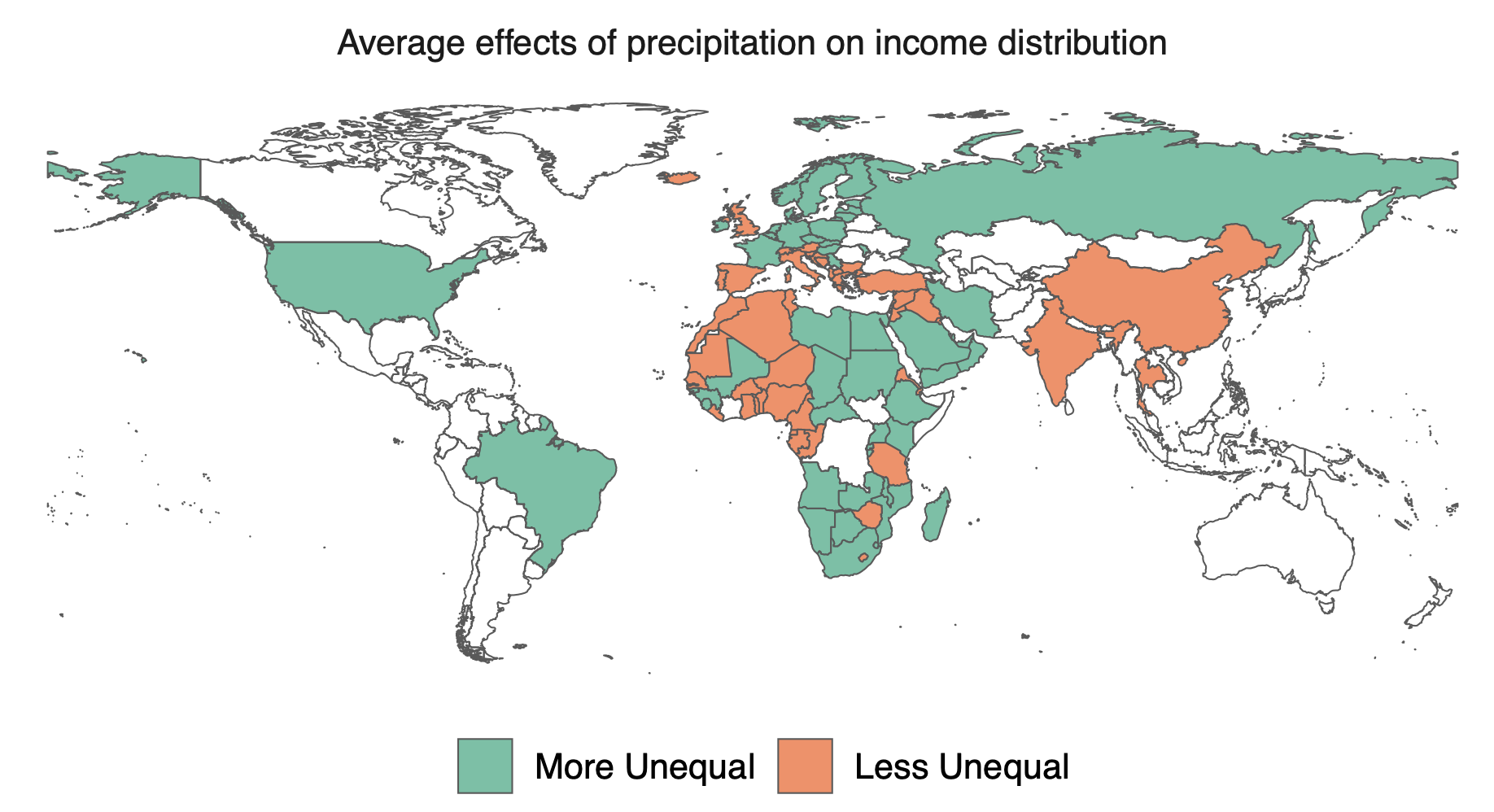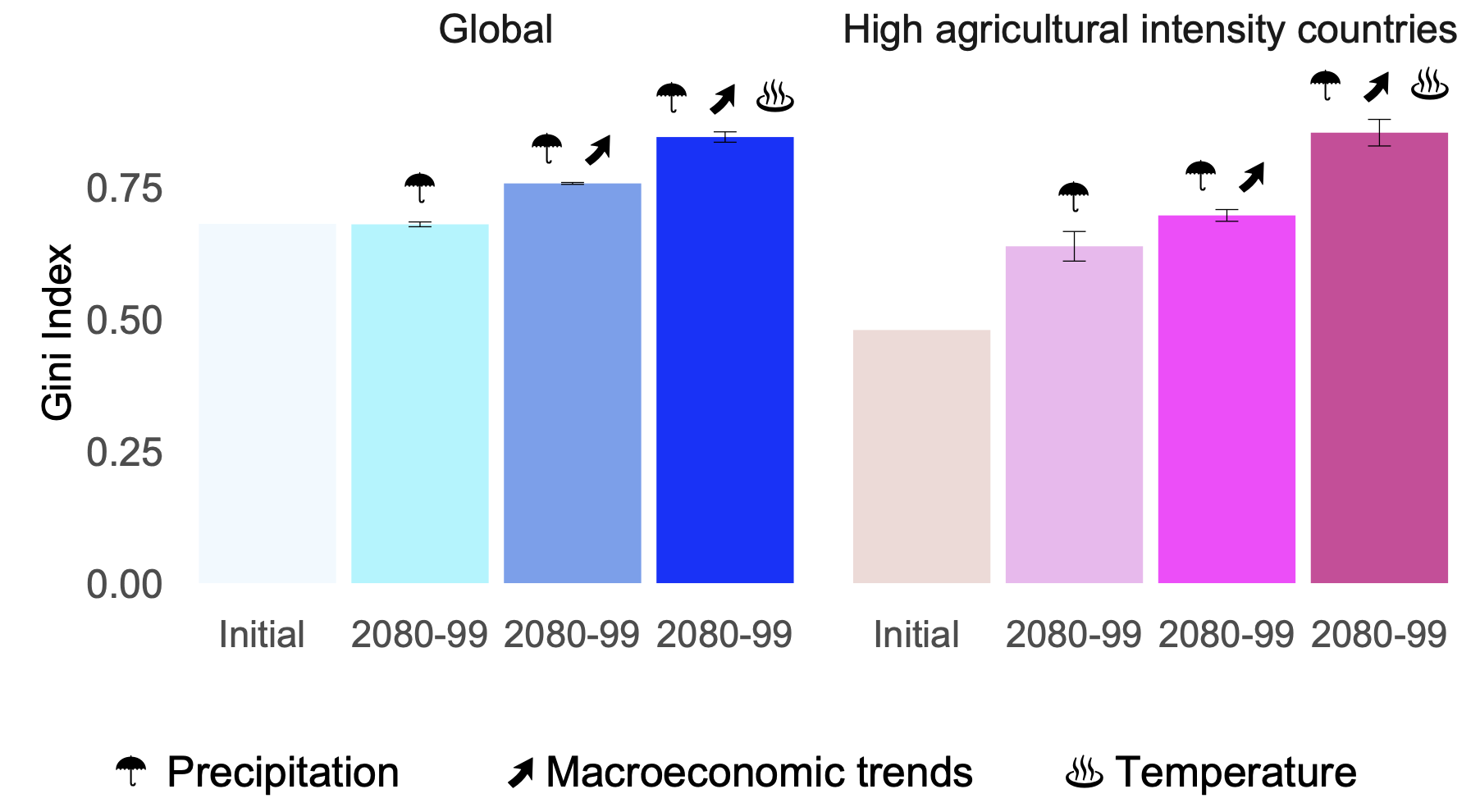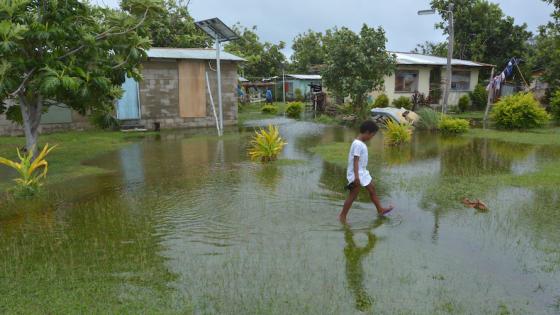Climate change and inequality represent two major societal challenges. And as the two phenomena are intimately intertwined (Chancel 2022), they need to be jointly addressed. While evidence indicates that climate change is likely to increase income inequality between regions and countries (Burke et al. 2015, Diffenbaugh and Burke 2019, Kalkuhl and Wenz 2020), its impacts across different income classes are far less understood.
With COP27 taking place in Sharm El-Sheikh, understanding how climatic shocks unequally impact different population groups is fundamental to guiding the discussion about future goals and steps.
In our study (Palagi et al. 2022), by jointly modelling the response to climate change of both between- and within-country income distribution, we present a framework that allows us to comprehensively account for the effects of climate anomalies on present and projected income inequalities. We find that precipitation anomalies brought about by climate change particularly hurt the poorest, especially in countries that heavily rely on the agricultural sector. Moreover, our projections not only indicate that 86% of countries in our sample will likely become poorer by the end of the century – with respect to a world without climate change – but also that global income inequality will increase, especially within and among developing economies. Regional disparities will also expand in Europe.
Climate change has increased inequality
Increasing climate change and extreme events affect societies around the world (Burke et al. 2015, Coronese et al. 2019). In a world of surging inequalities, we investigate whether climate change might have contributed to existing disparities. We analyze the impacts of climate anomalies on within-country income shares. Using data on the bottom-50% income shares from the World Inequality Database (Alvaredo et al. 2018) and yearly population-weighted total precipitation and average temperature from Burke et al. (2015), we employ a panel econometric model in which inequality depends on climate variables (temperature and precipitation), time-invariant socioeconomic and geographic factors, region-specific macroeconomic shocks, and the degree of country agricultural intensity.
We find evidence of an inverted-U-shaped relationship between precipitation and bottom income shares for high-agricultural-intensity countries (see Figure 1). Indeed, extreme levels of precipitation, either low or high, exacerbate income inequality in countries whose employment is highly concentrated in agriculture.
Figure 1 Estimated nonlinear impacts of precipitation on the bottom 50% shares
Source: adapted from Palagi et al. (2022).
Our approach further detects adverse impacts of extreme precipitation on both per capita GDP growth rates and, to a larger extent, per capita agricultural GDP growth rates (Kotz et al. 2022). Our results also show evidence of nonlinear impacts of temperature anomalies on GDP, with effects being stronger on agricultural GDP growth (see also Burke et al. 2015).
Why are the impacts of precipitation anomalies on inequality stronger in agriculturally intensive countries? This is due to two factors. First, impacts on aggregate income are smaller than those on agricultural income – the latter being highly correlated with bottom-50% income shares in agriculturally intensive countries. Second, bottom earners in those countries are largely dependent on income generated in the primary sector (Alston and Pardey 2014). As a consequence, climate anomalies translate into a widened rich-poor gap.
It never rains but it pours: Climate change will magnify inequality
Starting from our estimated impacts of temperatures and precipitation on bottom-50% income shares and per capita GDP growth rates, we build alternative projected paths. Our baseline projection combines a business-as-usual pathway of climate forcings (RCP 8.5) with historical trends in GDP and agricultural employment shares. We find that the majority of countries will experience worsened levels of income inequality as a consequence of precipitation anomalies (see Figure 2).
Figure 2 Average projected effects on bottom 50% shares due to precipitation
Source: adapted from Palagi et al. (2022).
Even considering the high uncertainty in climate projections, the outlooks are robustly negative across a range of possible futures. For example, in sub-Saharan Africa, the worst-case scenario indicates that income shares of the poorest 50% will shrink by more than 10% due to rainfall changes, while best-case projections indicate negligible positive effects. Further, in specific areas of the world, such as Europe, regional disparities will increase as impacts are projected to be positive for some countries (Nordic countries) and negative for neighbouring ones (Mediterranean countries). Finally, when factoring in the effects of temperature on economic growth, our projections indicate that 86% of countries will become poorer.
Climate change will increase global inequality
By jointly accounting for the evolution of aggregate income and its domestic distribution, our projections point to a 24% increase in global inequality, measured through the Gini index, as a consequence of future climate change (see Figure 3). The upsurge is remarkably higher for agriculturally intensive countries, i.e. whose Gini index is projected to increase by 45% when only altered precipitation is considered, and by 78% when changing temperatures are included.
By combining different shared socioeconomic pathways (SSP)–RCP pairs, we find that achieving growth and industrialisation in agriculturally intensive countries will substantially curb their vulnerability to future precipitation changes. Nonetheless, such a structural change is not enough to counterbalance the climate impacts in the fossil-fuel-based development pathway (SSP5–RCP8.5 future). Instead, inequality levels will remain more balanced in the scenario that combines high growth and contained emissions (SSP1–RCP2.6). This scenario analysis clearly shows that economic development along a sustainable pathway has the potential to smooth climatic impacts.
Figure 3 Projected evolution of income inequality
Source: adapted from Palagi et al. (2022).
Conclusions
Mounting evidence shows that climate change unequally affects the rich and poor sides of our societies. As such, global warming cannot be analysed without taking into account its distributional consequences. Not only are the responsibilities for emissions highly uneven (see e.g. Piketty and Chancel 2015), but impacts are heterogeneous across the income distribution.
Our study contributes to this debate, showing novel findings on the impacts of climate change on within-country inequality. More specifically, we find that variations in rainfall due to climate change have considerably hurt the poorest while hampering economic growth. Such effects are much stronger in agriculturally intensive countries, potentially leading to a further future increase in vulnerability and triggering a vicious cycle.
Our results suggest that sustainable economic development and gradual industrialisation of agriculturally-intensive economies can dampen the direct impacts of climate change beyond improving wellbeing. Development and climate-change policies should be jointly designed to effectively tackle such challenges.
References
Alston, J M, and P G Pardey (2014), “Agriculture in the global economy”, Journal of Economic Perspectives 28:121–46.
Alvaredo, F, L Chancel, T Piketty, E Saez, and G Zucman (2018), World inequality report 2018, Cambridge, MA: Belknap Press.
Burke, M, S M Hsiang, and E Miguel (2015), “Global non-linear effect of temperature on economic production”, Nature 527: 235–39.
Chancel, L (2022), “Global carbon inequality over 1990–2019”, Nature Sustainability 1-8.
Coronese, M, F Lamperti, K Keller, F Chiaromonte, and A Roventini (2019), “Evidence for sharp increase in the economic damages of extreme natural disasters”, Proceedings of the National Academy of Sciences of the USA 116, 21450–55.
Diffenbaugh, N S, and M Burke (2019), “Global warming has increased global economic inequality”, Proceedings of the National Academy of Sciences of the USA 116: 9808–13.
Docquier, F, J de Melo, C Deuster, and M Burzyński (2019), “Climate migration frightens... climate poverty is frightening!”, VoxEU.org, 10 December.
Foellmi, R, and E Baselgia (2022), “The inequality-growth nexus: It’s time to move beyond averages”, VoxEU.org, 28 October.
Kalkuhl, M, and L Wenz (2020), “The impact of climate conditions on economic production: Evidence from a global panel of regions”, Journal of Environmental Economics and Management 103: 102360.
Kotz, M, A Levermann, and L Wenz (2022), “The effect of rainfall changes on economic production”, Nature 601: 223–27.
Palagi, E, M Coronese, F Lamperti, and A Roventini (2022), “Climate change and the nonlinear impact of precipitation anomalies on income inequality”, Proceedings of the National Academy of Sciences of the USA 119(43): e2203595119.
Pleninger, R (2022), “Natural disasters reduce middle-class incomes”, VoxEU.org, 28 October.
Piketty, T, and L Chancel (2015), “Carbon and inequality: From Kyoto to Paris”, VoxEU.org, 1 December.










